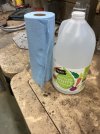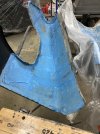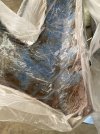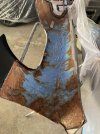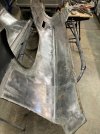For my Cutlass hood I made a "tub" using 6X6s arranged like a sandbox, lined with heavy duty plastic.
Then GENTLY (engine hoist) lowered the hood into the box. Fortunately, I already had the citric mixed in a large tote and just siphoned it into the "sandbox". After a week I pulled it out and went after it with a pressure washer then another week and repeat.
While mine was not near as bad as yours it actually worked pretty good. I liked the way the acid wicked into the lapped panels and the pressure washer blew the debris out.
Note: Once it was all set up I covered it with plastic to help minimize evaporation.
Good Luck and keep us posted.

